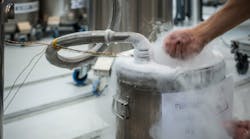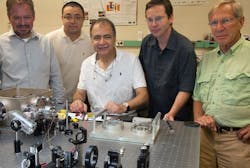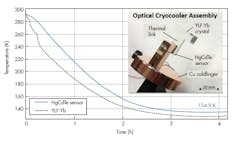Cooling objects to temperatures far below freezing is critical; in many disciplines, as well as in a wide range of scientific and national security applications. But until now, mechanical refrigeration has been the way to get refrigeration units to operate continuously in remote locations such as in space. However, all mechanical cryocoolers have moving parts that not only limit their reliability but also introduce mechanical vibrations and microphonic noise that limit performance.
Recently, however, a team of researchers from the Los Alamos National Laboratory and the University of New Mexico have for the first time demonstrated an all-solid-state optical refrigerator that operates at cryogenic temperatures and has no moving parts.
Researchers analyze the solid-state optical cryocooler characterization they built. Pictured from left to right are Markus Hehlen (LANL), Junwei Meng (UNM), Mansoor-Sheik Bahae (UNM), Alexander Albrecht (UNM), and Richard Epstein (UNM).
Solid-state cryocooling is an optical effect in certain materials that takes advantage of anti-Stokes fluorescence. In this process, a solid excited by a laser subsequently fluoresces at a slightly greater mean energy (shorter wavelength) than that of the exciting laser. The corresponding energy difference is provided by phonon energy (heat) extracted from the solid and carried away as light, thus cooling the solid in the process. This effect was first observed by Richard Epstein at Los Alamos National Laboratory in 1995.
The Los Alamos team worked 20 years to develop ultrapure rare-earth-doped crystals such as Yb3+-doped YLiF4 (YLF:Yb) that have the required spectrally narrow optical transitions and greater than 99% quantum yields. Previous work had only cooled the YLF:Yb crystal itself. Cooling a useful payload such as a sensor by using a YLF:Yb crystal, however, posed a range of additional engineering challenges.
The solid-state laser cooled an HgCdTe sensor to 135 K using a YLF:Yb crystal. The solid curve shows the sensor temperature as a function of time after turning on the pump laser (47W at 1,020 nm). The inset is a picture of the optical cryocooler assembly developed in this project.
To get to the point they could build the new solid-state cryocooler, the team had to develop 1.) a custom-shaped thermal link that connected the YLF:Yb crystal to the sensor with good thermal conductivity, while rejecting the intense crystal fluorescence; 2.) an adhesives-free bond that could attach the thermal link to the YLF:Yb crystal; and 3.) silica aerogel support that secured the cooled assembly inside the cryocooler with as little conductive heat load as possible. These advances have enabled laser-cooling of a HgCdTe infrared sensor to 135 K (−216.67°F) for the first time.



